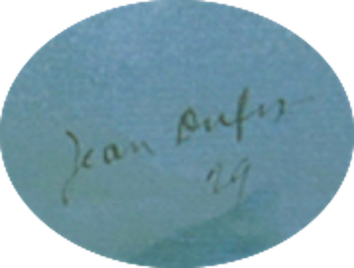

(Le Havre, 1888 - Boussay, 1964)

Jean Dufy was born in 1888 in Le Havre, the seventh of a family of eleven children, an accountant father in a metallurgical company, talented amateur musician. From his youth in Le Havre, few pictorial traces have come to us.
It was during this period that the artistic sensibility of the painter was formed, through his readings by Baudelaire, Mallarmé and Rimbaud, and thanks to the 1906 exhibition in Le Havre, where he discovered Matisse, Derain, Marquet and Picasso.
After his military service (1910-1912), he was the installation in Paris, the meeting with Derain, Braque, Picasso, Apollinaire. In his first watercolors, exposed at the Berthe Weill Gallery in 1914, the dark, brown, blue, dark red tones, rub shoulders with the technique of hatching inherited from Cézanne through the work of his brother Raoul. The mobilization, after this first exhibition, does not prevent Jean from continuing to paint or draw on carnets, mainly flowers, horses, landscapes. After a short collaboration with his brother for the workshop on fabric painting of the famous Lyonian Bianchini-Férier, in 1916 and for more than thirty years, Jean made the decorations for the porcelain Théodore Haviland de Limoges - floral and animal - which won him a gold medal for the service "Châteaux de France" at the International Exhibition of Decorative Arts in 1925.
Back in Paris, in 1920, Jean moved to Montmartre, where Georges Braque is his neighbor. His works are finally shown in public at successive exhibitions in Paris (Salon d'Automne at the Grand Palais des Champs-Elysées, Bing Gallery) and in New York (Balzac Galleries and Perls Galleries) reveal his colorist gifts.
Two events in the post-war Parisian cultural life marked the artist's itinerary, the comedy Le Bœuf sur le toit in 1920, which gave him the opportunity to meet the musicians of the time (Darius Milhaud, Georges Auric, Erik Satie, Francis Poulenc and Arthur Honegger), La Revue Nègre, in 1925, which in his work determined the new alliance of chromaticism and music, at the origin of exceptional canvases. The theme of music inspires many versions of pianists and orchestras. It was also, at the same time, a tribute to the Fratellini brothers: paintings of circuses and clowns, from which came the color-music, the color-language, the play of light and the predilection for white, omnipresent, Usually reserved for clowns, horses and athletes. The circus (1927) is the apotheosis: a powerful chromatic background made of red, blue, black and yellow, striking homage to the white.
During the following years, many stays in Le Havre gave rise to masterpieces such as Le quai Videcoq in Le Havre (1929), where the harmony of colors reached perfection. Honfleur, the birthplace of his mother, Villefranche-sur-Mer, where he stayed since 1920, then Limousin and Touraine, where he lived with his wife for part of the year, inspired others of his finest works: Views of forests and valleys, views of the Lion Castle.
For the International Exhibition of 1937, the Director General of the C.P.D.E. (Parisian Electricity Distribution Company) instructs his brother, Raoul Dufy, to execute the decoration of the Electricity Pavilion. Jean will help him to create a vast fresco to the glory of electricity on a surface of six hundred square meters.
The last years (1950-1960) were devoted to travel, mainly in Europe (Italy and Greece, England and Ireland, Austria, Denmark, Sweden and the Netherlands, Spain and Portugal) and in North Africa. But it is Paris, Paris, definitely, which, for thirty-five years, will have its preference. Like his contemporaries Aragon, Hemingway or Prévert who describe it, Utrillo, Chagall or Marquet who paint it, Jean Dufy will choose Paris tirelessly, for oils or watercolors, according to a creative process constantly renewed dominated by a harmony of Blues: blue as the source of insatiable creation of the gates of Paris, the streets, the carriages, the Eiffel tower, the sky, the Seine.
Recognized artist, regularly exhibited in Paris, in the United States, integrated in the collections of the most prestigious European and American museums, like the National Museum of Modern Art, Centre Pompidou in Paris, the Albertina Museum in Vienna, Of the Art Institute of Chicago or MoMA in New York, Jean Dufy died on 12 May 1964 in La Boissière, a village in the village of Boussay, two months after the death of his wife Ismérie.
- Excerpts from the Biography of Jean Dufy by Jacques Bailly, expert of the artist -